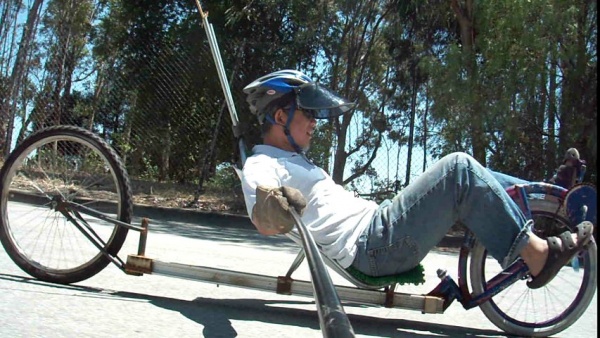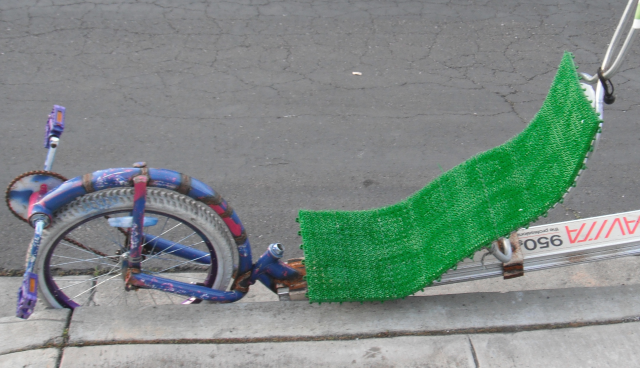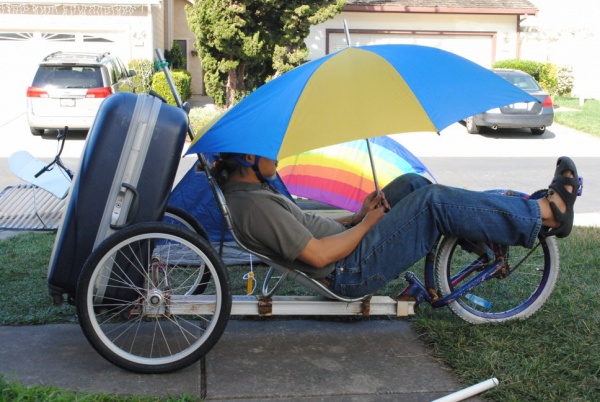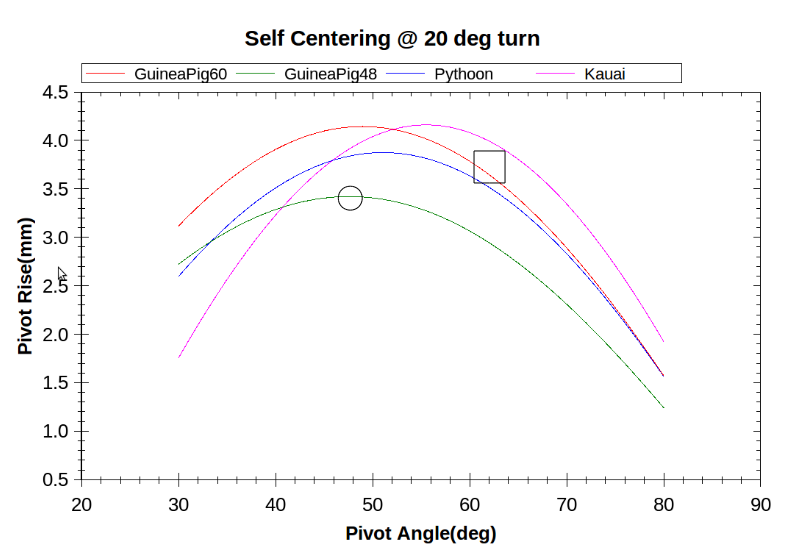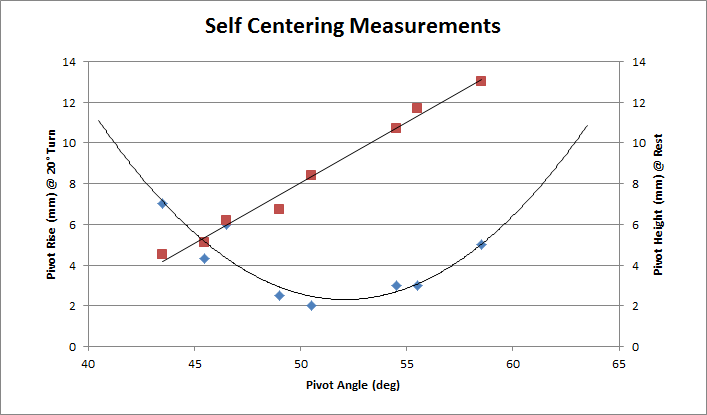Guinea Pig
46 deg pivot configuration with 24" rear wheel
Concept
To minimize development materials, cost, and time, a modular test frame is set up for quick trial of new/different designs/components. Minimizing the number of parameters being changed at one time also helps cross comparison. The main beam is made of extruded aluminum, which came from a recycled AVITA 950 rowing machine.
Design
Modules have rectangular mounts/sleeves that slide along the beam, and are secured by 1 or 2 bolts or just friction.
Arch bottom bracket frame has dual purposes, minimizing BB2hub distance and serving as a fender.
Floating traing wheels are connected by a ~30-inch tube, and are operated by hands (floating over the frame rather fixed). When the bike leans, pressure is applied to create traction. Hands resting on wheels costs some friction and noise. Wheels can be lifted with and twist of the wrists.
Tall head rest tubes - are useful for hanging on while leaning into a corner, mounting camera, holding flags, strong enough for standing passenger to hold on, or strapping a luggage...
Build
Front modules:
- 16 inch python drive, pivot angles ~ 45, 1st arch frame, now part of the Bango quad
- 20 inch python drive, pivot angles ~ 50, 2nd arch frame
Middle modules:
- Seat modules occupy the mid section of the frame. Added seat pad made out of 3 square synthetic grass mats for better grip + fit = control, and ventilation.
- The rowing machine sliding seat is still in good condition, and is very cushy. It can be used for a small passenger, or for actual rowing functionality someday...
- Floating training wheels go under the seat and over the main beam.
Rear modules:
- Rowing machine foot rest, 1/2in bar strong enough to stand on, good for a luggage also.
- 20 inch trike wheels with quick release, from a recycled Baby Jogger
- 26 inch bike wheel, cannot be used with foot rest
Test
The beam twists quite a bit as a python trike, so not sure how long it will last. Other than that, the trike form is really fun, tight turns, wide track (32in), low COG, and lean in turn...
Some rectangular sleeves were made too tight, shrunk after welded? Tough to put on or remove, but tight enough without bolting
Training wheels work on first trial, help a lot on wet/rough surfaces, and should be safer and smoother than hand walking.
Foot rest is quite functional, and fun for kids to stand on or ride like a scooter.
45-50deg pivot angle is nice for minimizing pedal steer on a trike, but proved to be very flawed for a bike. Luckily, the 26" rear wheel module can be flipped upside down to achieve a 60-deg pivot for the bike. Even with the same python drive and seat module, switching between the bike and trike rear wheels feels very different.
Simulated pivot rise vs pivot angle, from DirkB's software.
Measured pivot rise vs pivot angle by tilting the whole bike with different rear wheel sizes (26-6in), with rider on the seat, feet on the ground. The opposite trend is puzzling.
Training
The trike rear wheels were build first, so little training is needed, other than learning to lean into a corner.
The bike rear wheel was built on a raining day, so first test ride was pretty wet and rough, and lasted only 10min. Not until a couple of months later that I decided to build training wheels for another go at it, incidentally also on a rainy day.
2/20/11 - The floating training wheels help a lot, with just some arm pressure / weight. At moderate speed, very little pressure is needed, but it's better to keep the wheels on the ground for smooth adjustments. Going too fast, pedal steer can induce imbalance. Over time, the arms do get quite a bit of work out, good or bad. During a turn, the wheels can be slided out away from the corner to minimize turning resistance. Not sure how many kilometers it will take before they are not needed, but they should be useful as landing gears with heavy load.
2/26/11 - Decided to try without the training wheels today, and was surprised that I can actually start and go for a few meters at a time. The meandering motion of the balancing act is true to the reptile name Python. I am able to use the center steering force to get back in line instead of just falling to one side. The experience is different from using the training wheels, which is like a trike. I supposed the training wheels are still good for getting to an open parking lot safely...
3/13/11 - Went on the street w/ the training wheels for a longer ride, ~6km, but didn't gain much balance if any. As is (48 deg pivot angle, 20in wheels), the bike must be very flawed, so maybe a cool handlebar like the Kouign Amann will be my last attempt before donating it to a trike/quad, then move on with the next guinea pig module (65 deg, 24 in) which may be the limit of my inseam...
3/15/11 - With input from Jürgen, I decided to change the flawed pivot angle from 48 to 60, by flipping the rear wheel module upside down to tilt the whole bike forward. Magic, I can ride it on first trial :) Ground clearance also improved, but seat angle became a little too upright ~40 deg to stop me from sliding off forward. I can also push it forward by the headrest. Perhaps this is a good objective test for ride-ability, independent of hip coordination...[youtube]
3/18/11 - with 2 rear frame combinations, and various rear wheels (6-26"), I was able to test pivot angles from 46-58deg, which all seem to give better control than 48deg.
3/20/11 - 20km today, with 20in & 56deg pivot; 3km on the street was a bit nervous, but calm on the trail, mostly alone. Fell off a few times when distracted / not focusing, but balance can be maintained with eyes closed :) Braking does straighten out the bike nicely, but using coaster brake in emergency is 50/50 chance, depending the pedal position. Off road, loose gravel, wet dirt / mud surface is very different from dry asphalt; see the slippery fall
4/1/11 - Settling down with 24" wheel w/ 55 & 46 pivot, large pivot angle is easier to control but higher seat angle causes slipping out of the seat...
7/23/11 - more comfortable riding 46 deg pivot configuration due to the seat angle (30 deg), can ride handle-free now (see video)
11/13/11 - the longer wheelbase giving more traction to front wheel seems to help with slipper surface (gravel), compared to short wheelbase. Lower seat height also eases the fall... (youtube video)
Links
Vi, Futon Express, Bango, Flintstones, μPython, Mini Python, Guinea Pig, Bipolar, FP02, FS24P
| Pivot Angle [°] | Trail [cm] | Seat Height [cm] | BB-Seat Diff. [cm] | Ground Clearance [cm] | Wheelbase [cm] | Weight [kg] | BB-FWA [cm] | BB-EOS [cm] | Turning Circle [m] | Front Tubing [mm] | Wheel Size [inch] | CG [%] |
| 48 | -13 | 16 | 32 | 9 | 190 | ? | 29 | 66 | ? | 45,30,20 round | 20" 26" | ~60 |
| 60 | -17 | 24 | 24 | 14 | 190 | ? | 29 | 66 | ? | 45,30,20 round | 20" 26" | ~60 |
